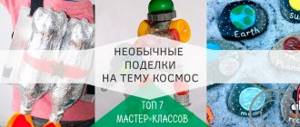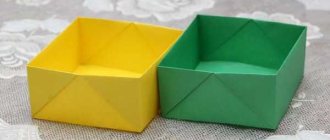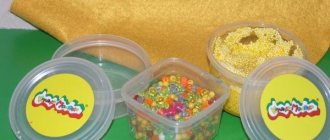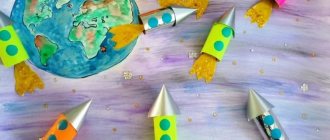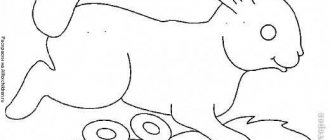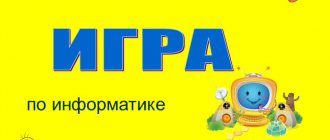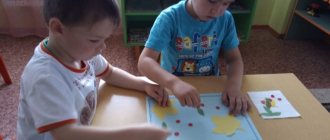Technology Proceedings 4th grade Workbook Rogovtseva Anashchenkova
Technology Proceedings 4th grade Workbook by Rogovtsev Anashchenkov - 2014-2015-2016-2017: Read online (download in PDF format) - Click!
<Return> |
<Explanation: How to download?> Explanation: To download a book (from Google Drive), click on the top right - ARROW IN RECTANGLE. Then in the new window at the top right - DOWN ARROW. To read, just scroll the pages up and down with the wheel. Text from the book:
Russian Academy of Sciences Russian Academy of Education Publishing House "Prosveshchenie" P E R s P E K T I V A N.I. ROGOVTSEVA S.V. ANASCHENKOVA if ECHNOLOGY Workbook: fgos Russian Academy of Sciences Russian Academy of Education Publishing House "Prosveshchenie" PERSPECTIVE N. and. Rogovtseva S.V. Anashchenkova Workbook 4th grade Manual for students of general education institutions 2nd edition Moscow “Enlightenment” 2012 UDC 373.167.1:62 BBK 30.6ya72 R59 Series “Academic school textbook” was founded in 2005 Project “Russian Academy of Sciences, Russian Academy of Education, publishing house "Prosveshchenie" - Russian school" Project leaders: Vice-President of the Russian Academy of Sciences, academician. V.V. Kozlov, President of RAO Acad. N. D. Nikandrov, General Director of the Prosveshcheniye Publishing House, corresponding member. RAO A. M. Kondakov Scientific editors of the series: acad. RAO, Dr. Ped. Sciences A. A. Kuznetsov, Acad. RAO, Dr. Ped. Sciences M.V. Ryzhakov, Doctor of Economics Sciences S. V. Sidorenko The “Perspective” series was founded in 2006. The workbook was compiled in accordance with the requirements of the Federal State Educational Standard for Primary General Education. The manual contains an extensive methodological tool for mastering universal educational activities: templates of parts with drawings, technological maps, tests and other tasks. Completing tasks from the workbook helps students consolidate the practical skills acquired in technology lessons. Thematically and structurally, the material in the notebook corresponds to the content of the textbook. ISBN 978-5-09-029323-5 © Prosveshcheniye Publishing House, 2011 © Artistic design. Publishing house "Prosveshchenie", 2012 All rights reserved Dear friends! In this workbook you will find materials to help you complete projects and create interesting products. These are drawings and templates of parts that are necessary for working on products, and technological maps, by filling out which you will learn how to independently draw up a work plan, determine techniques and methods for its implementation, select the necessary materials, tools and devices, calculate the cost of the product, conduct a presentation of your work and her assessment. At the beginning of the notebook there is a contour map of Russia. On it you will find and mark cities in which large industrial enterprises of the leading industries of our country are located. In addition, the notebook contains a variety of tasks and tests. While completing tasks, you will analyze, compare, find and systematize information, and draw conclusions. And with the help of tests you can test your knowledge. Good luck to you in your work! Authors » % Map of Russia -L / Symbols Come up with and draw symbols for industrial enterprises, with the help of which you will mark the cities in which these enterprises are located on the map of Russia. Carriage factory Car factory Earthenware factory Garment factory Shoe factory Confectionery factory Port Aviation plant Carriage factory Test tfBaroHbi» 1. Look at the railway cars shown in the pictures. Determine what goods are transported in each of them. Connect the corresponding image and definition with an arrow. Definition - flat wagon for transporting cars - flat wagon for transporting timber - covered wagon for transporting livestock - flat wagon for transporting bulky goods (building materials, containers, machines) that do not require protection from precipitation 2. Insert the missing words and complete the sentence. The main elements of the car design: ____________ Car model. depends on the purpose i# Car chassis (bogie) Read the work plan for the product “Car chassis (bogie)” on p. 13 textbooks. Fill out the technological map. Technological map Sequence of work Techniques, methods of execution Materials, tools and devices Assessment of the quality of work Sketch Marking Cutting Assembly Finishing Final assessment of the work: Approximate cost of the product: Compare the product manufacturing plan with the technological map. Make a conclusion: which document is more detailed. Justify your answer. nr Make drawings of the development of the base and protrusion, wheel parts on a scale of 1:1 on a sheet of colored cardboard (or thick paper). Make the product as shown in the tutorial. Drawing of the carriage chassis on a scale of 1: 1 "u 60 'U//// Sh o o Sh'u sh ill Base development (4 parts) Passenger car Read the work plan for the product, determine and select the necessary materials and tools and manufacture model of a passenger carriage. Work plan 1. Read the product drawing. Make drawings of the body, roof parts and end walls on a scale of 1:1 on a sheet of colored cardboard (or thick paper). 2, Cut out the development and parts. 3. Bend the body, roof and end wall blanks along the fold lines. 4. Glue the end walls to the body part using flaps. 5. Glue the roof as shown in the picture. 6. Glue the car onto two running parts (carts) prepared in advance. 7. Design the product. V '-X \ \ ■ : I \ .. -g J 0 Drawing of a passenger car on a scale of 1: 2 End wall (2 parts) % At the Tver Carriage Plant they developed and manufactured a car of a new design for our country - a double-decker passenger car. This carriage has 16 compartments (8 each on the first and second floors), each compartment has 4 sleeping places, a service compartment for conductors and 3 toilet rooms. Soon such cars will appear on Russian railways. Look at the photo - this is what a double-decker carriage looks like from the outside. Try to imagine and draw what this carriage might look like from the inside. Cisgerna. Assembling the carriage Using the drawings on p. 16, 17 of the textbook, determine and select the materials and tools that are needed to make a model of the tank. Fill out the technological map. Technological map Sequence of work Techniques, methods of execution Materials, tools and devices Assessment of the quality of work Sketch Marking Cutting Assembly Finishing Final assessment of the work: Approximate cost of the product: Determine the correct sequence of the technological process (fill in the appropriate numbers in the boxes). Sequence of operations for manufacturing a model of a tank car: assembling the body, attaching the body to the stand, assembling the chassis, installing the stand on the chassis. or thick paper). Make a tank model as shown in the tutorial. Drawing of a tank on a scale of 1: 2 (2 parts) Minerals Test “How oil is extracted” 1. Determine the correct sequence of the technological process (fill in the appropriate numbers in the boxes). The sequence of operations for oil production and transportation: drilling wells, searching for oil fields, transporting oil through pipelines or in tanks, building drilling rigs, preparing fields for development 2. Select the correct answer (check it). Oil and gas fields are depicted on maps using the following symbols: l s 3. Fill in the missing words and complete the sentences. A drilling rig is a structure above ________________ _______________, designed for lowering and ascent* In its shape, a drilling rig is similar
uchebnik-skachatj-besplatno.com
How to make a train with a motor and a remote control from cardboard and lids?
Video with the process of making and testing a paper train.
In this article, we will show you how to make a railroad out of cardboard and caps, as well as a remote control with which we will control the train.
We will need:
— corrugated cardboard — a motor with a gearbox, purchased on AliExpress.com — an old USB cable with a socket — a piece of elastic sheet metal — plastic bottle caps — a piece of plastic (you can take an old CD) — a soldering iron, wire cutters and other tools.
Manufacturing of the railway:
1: Making a train.
First of all, cut out the base of the train as in the picture.
Next, we mark the location for the engine and make a seat for it.
We also make holes for the gearbox axle where we install the wheels.
We prepare the lids, cut off the excess part and smooth the edge, making the small lids the same size as the large ones.
We cut out a circle from a CD or similar plastic that is a few millimeters larger than the prepared caps.
We wind copper wire onto large wheels, after sanding it free of varnish; these wheels will be electrically conductive.
We fix the wire with super glue on the lid.
We select a pair of capacitors with approximately the same diameter as the axis of the gearbox shaft and disassemble them. We only need the outer aluminum part of the capacitors.
We place a “U” shaped wire on the gearbox axis and secure it by installing a 3 cm wire.
We install the prepared gearbox on the train frame and glue it with thermal glue.
We make two sliding contacts from wire that will slide along the aluminum sleeves on the gearbox axis.
We make hooks at the ends of the wire and attach an elastic band so that there is good contact.
We solder the wires to the other end and connect them to the motor.
We solder the wires from the electric wheels to the axle, a plastic circle with glue also to the axle, and a cover to it, we make the rest of the wheels in a similar way only without electrical contacts.
We glue two cut cotton swabs to the smaller box, into which we install the axial wire with wheels.
2: Making the railway.
We cut the cardboard into long strips, these will be rails and short strips for sleepers. We also cut out the connecting points as in the picture.
We tear off a strip of ordinary kitchen foil and wrap it around the rails.
It should look something like the photo. We are trying to make the road with a larger diameter, so the train stays on the tracks better.
We glue the auxiliary segments on the sides in the connecting areas so that the rails in these places do not move to the right and left.
We glue one section to solid cardboard, there will be a station. In the corner of the station near the rails we draw two wires and screw them to the rails, wrap them with foil on top to hide the wires and make better contact.
3: Making a remote control.
We make two holes in the lid for toothpicks. We place one toothpick in the center, and the second on the edge of the lid. We place the side toothpick so that it protrudes a little by 5 mm, and bite off the rest.
We glue paper plugs on the inside of the lid and leave a toothpick sticking out on both sides.
We make rounded contacts with a metal contact protrusion. And glue it to the lid with hot glue.
We also make a “P”-shaped contact and screw the wire in the middle.
We put them together so that one side is parallel and the other is crosswise. We insulate the crossed contact with heat shrink.
We glue the contacts and the cover to the base of the remote control so that the rotating contacts of the cover are inside the stationary ones.
Secure the rotary lid with a cardboard washer.
Cut and glue a compartment for three AA batteries
We also cut out the contacts for the batteries from elastic sheet metal and install them in their place.
We solder the wires to the battery compartment and glue them into place in the remote control.
We fix the wire on the remote control and solder it to the cover with contacts.
We make a loop from the elastic band for money and glue it on the side protrusion of the lid, and fix the other two ends with thermal glue on the remote control body. This is necessary so that when the gas is released, the train will automatically stop.
We use ice cream sticks to make a lever for moving forward and backward and assemble the remaining parts of the body from the remote control.
For convenience, we attach a thread to the battery compartment so that by pulling it you can easily remove the batteries.
4: Train contact improvement and test.
When operating a train, a loss of contact between the wheels and rails may occur and the toy will stop.
In order for the contact to be reliable under the train, it is necessary to make two contacts that will remove electricity from the rails.
Also, to prevent the train from slipping on the rails, it is necessary to put rubber bands on the wheels, and attach some kind of weight to the train itself.
We use wire to make hooks between the cars and glue them into place.
We assemble the railway, connect it at the joints and put on rubber bands.
We connect the remote control to the road, everything is ready.
We press on the gas and the locomotive starts moving along the rails.
Conclusion:
You'll make a fun DIY paper railroad. All children will be happy to make their own crafts. The manufacturing process requires a lot of perseverance and develops fine motor skills. And you need to play with the craft carefully; after all, it is paper and fragile. Thank you for your attention.
Become the author of the site, publish your own articles, descriptions of homemade products and pay for the text. Read more here.
Making a cart from cardboard and newspapers
Let's take a piece of cardboard and draw our future cart, bottom and sides. | |||||||||||||||
Let's cut out the cardboard and make slits for the sides, we will have 4 slits. | |||||||||||||||
Where on the cardboard we will draw lines with a blunt object to make it easier to fold the edges of the cart. We draw with a blunt object along all the drawn lines. | |||||||||||||||
After cutting the sides and drawing with a blunt object, this is what our cart looks like. | |||||||||||||||
Now it’s easy to make boxes and secure the sides. We fix it with glue or a stapler. | |||||||||||||||
The box is ready, now we need to make 4 wheels from newspaper strips, and we need two wooden sticks. I’ll repeat how to make wheels: www.livemaster.ru
|
